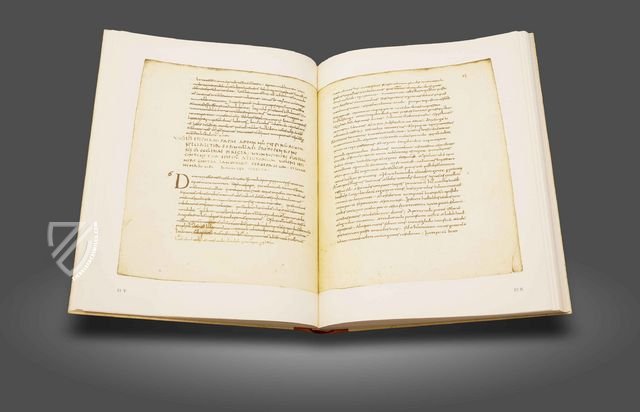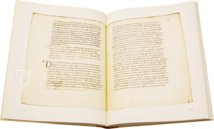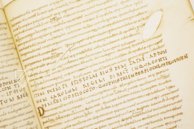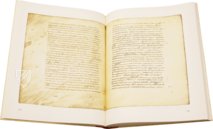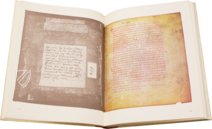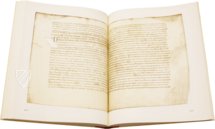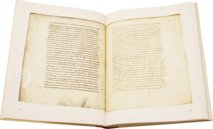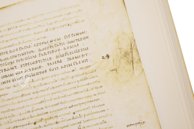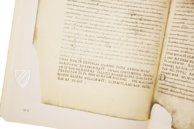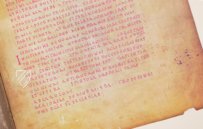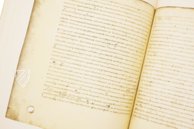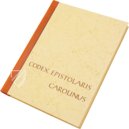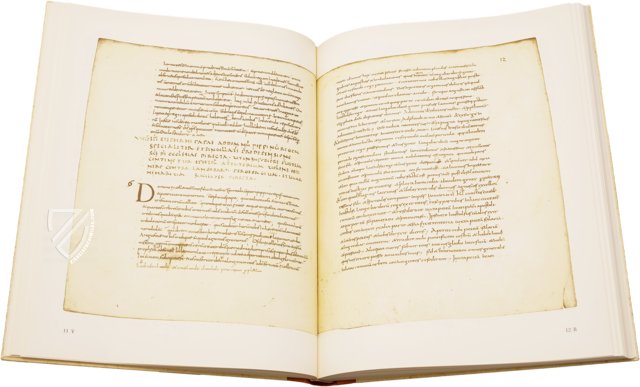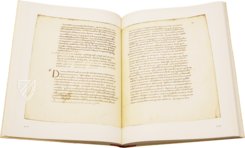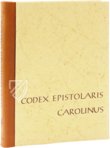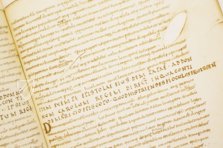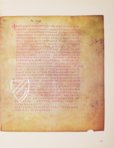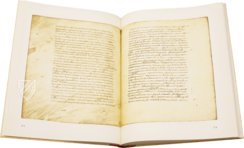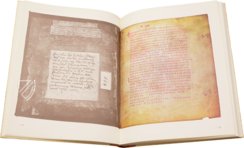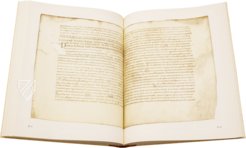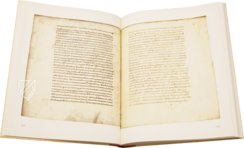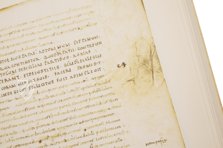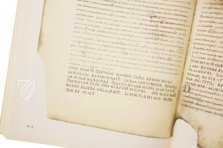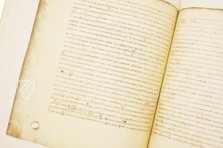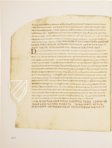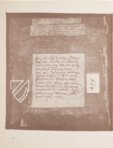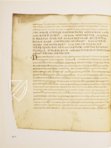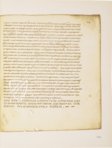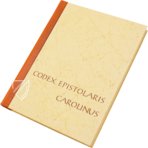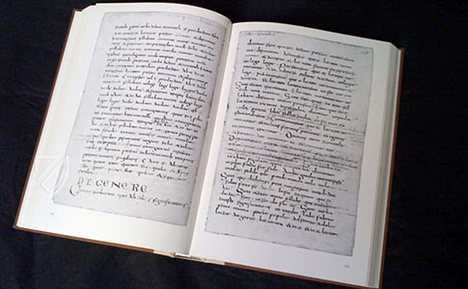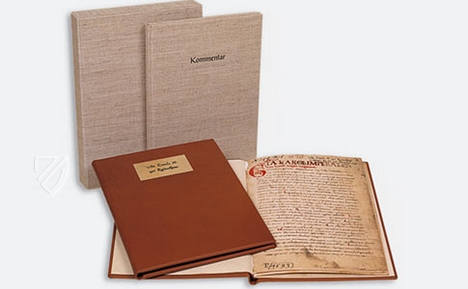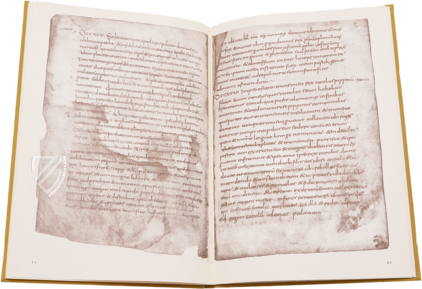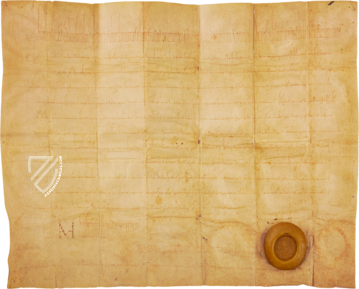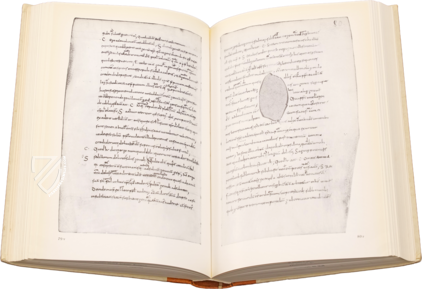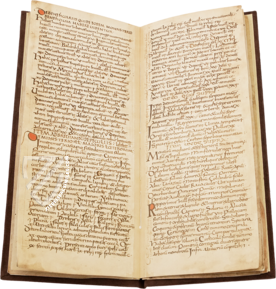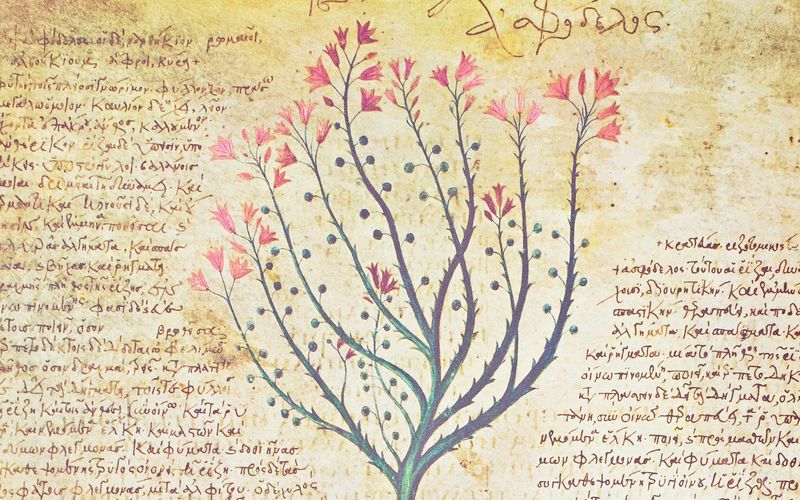Codex Epistolaris Carolinus
(under 1,000€)
It was Charlemagne himself (742–814) who commissioned this special collection of letters in 791: as stated in the praefatio, the preface, he wanted to save 99 important letters from the years 739 to 791 from decay and dissolution that seven early medieval (anti) popes had addressed to his grandfather, the Mayor of Palace Charles Martel (around 690–741), his father Pippin the Younger (714–768, as well as to himself. Therefore, he ordered them to be copied again and thus created a collection of great significance in terms of church and political history. The Austrian National Library holds the only surviving copy of this valuable collection of letters, which was preserved for posterity in the 9th century by four scribes in neat Carolingian minuscule and was in the possession of Archbishop Willibert of Cologne (870–889). The manuscript is one of the most important and most useful sources on the historical relationship between the papacy and the Frankish Empire.
Codex Epistolaris Carolinus
The relationship between church and state is one of the defining features of medieval Europe and touched every aspect of life from peasants and priests to kings and popes. Charlemagne (742–814) commissioned a collection of 99 letters from reigning popes to Carolingian rulers dating between the years 739 and 791 concerning the subject and had them bound into a codex. The resulting manuscript is an invaluable source for researchers of political and church history in the Early Middle Ages and although it is now lost, its contents survive in this precious late-9th century codex, the only extant copy that is preserved in the Austrian National Library.
The letters originate from the popes Gregory III, Zacharias I, Stephen II, Paul I, Stephen III, and Hadrian I as well as two letters from Antipope Constantine II. They correspond to the reigns of the Frankish kings Charles Martel, Pippin the Younger, Carloman, and Charlemagne. He ordered that these letters, many of them in poor condition, be recorded so that the “wisdom of the ancients” would be preserved for posterity. It also reflects a period of religious reform at the Carolingian Court and an attempt to restore orthodoxy in the face of heresy and some questionable decisions made at the Second Council of Nicaea in 787. These letters thus contain religious instruction from the highest authority that was meant to expel all doubt on various subjects, especially the relationship between church and state.
A Collection of Official Documents
Habent sua data libelli – this saying from Terentianus Maurus can be quoted in few manuscripts with as much justification as the Codex Epistolaris Carolinus. According to the introduction (fol. 1r), the collection of these letters was compiled in 791 at the behest of Charlemagne. The copy that has come down to us is no longer the original codex, but the later and only preserved copy according to an already book-like template, but without any chronological order of the pieces.
It contains the most important political and ecclesiastical documents on the history of the relations of the Frankish Empire with the papacy in the second half of the 8th century, from which the turbulent fate of the relationship between pope and emperor with its ups and downs received its direction. This alone proves the enormous historical value of this manuscript, which originates from Cologne, from the possession of Archbishop Willibert (870–889) and was executed by four scribes in a more or less regular Carolingian minuscule.
Codicology
- Size / Format
- 200 pages / 28.5 × 25.0 cm
- Origin
- Germany
- Date
- 9th century
- Epochs
- Style
- Language
- Script
- Carolingian minuscule Rustic capitals
- Illustrations
- Initials and red display script
- Content
- 99 papal letters to Carolingian rulers dating between the years 739 and 791
- Artist / School
- 4 scribes
- Previous Owners
- Willibert, Archbishop of Cologne (870–889)
Codex Epistolaris Carolinus
The Fourth Hand
The Codex Carolinus was written by altogether four hands, of which the fourth took over the largest part. This scribe was also responsible for the so-called lemmata, by which are meant the synoptic "headings" in an elegant capitalis rustica. The copied letters were written throughout in a neat Carolingian minuscule, with the fourth hand being particularly even as well as small and rounded. The numbering of the letters in Arabic numerals, usually applied at the level of the initial, are not original and were most likely added by Peter Lambeck, who researched and edited the work in the 17th century. He is also responsible for the modern foliation.
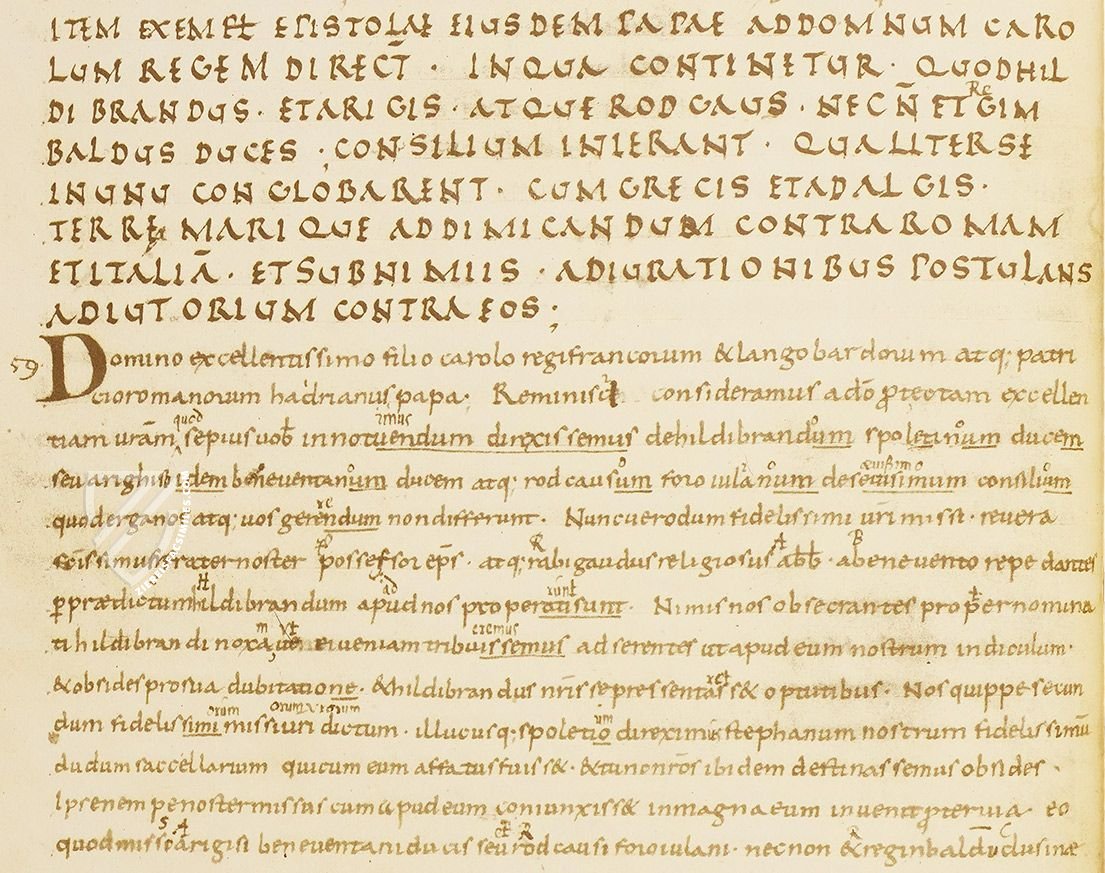
Codex Epistolaris Carolinus
Letter 93: Hadrian I to Charlemagne
Sometime between April 781 and April 783, Pope Hadrian I wrote Charlemagne, who was still king of the Frankish Empire at the time, this short letter, beginning with a initial 'D', to inform him of the Persian invasion of the Byzantine Empire.
At this time, during the reign of Empress Irene, who ruled for her young son Constantine VI, the Byzantine Empire was under constant pressure from the imperial ambitions of the neighboring Persian Empire. Under the premise of establishing peace and cohesion between the Christians of the Eastern and Western Churches, Hadrian I thus supported communication between Byzantium and the Frankish Empire, which eventually resulted in an alliance between Irene and Charlemagne in 787.
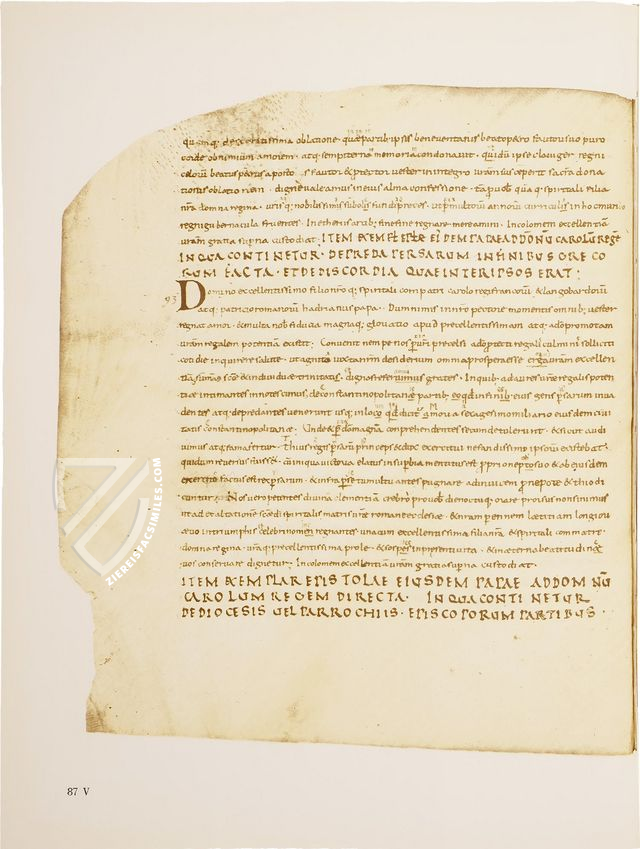
#1 Codex Epistolaris Carolinus
Language: German
(under 1,000€)
- Treatises / Secular Books
- Apocalypses / Beatus
- Astronomy / Astrology
- Bestiaries
- Bibles / Gospels
- Chronicles / History / Law
- Geography / Maps
- Saints' Lives
- Islam / Oriental
- Judaism / Hebrew
- Single Leaf Collections
- Leonardo da Vinci
- Literature / Poetry
- Liturgical Manuscripts
- Medicine / Botany / Alchemy
- Music
- Mythology / Prophecies
- Psalters
- Other Religious Books
- Games / Hunting
- Private Devotion Books
- Other Genres
- Afghanistan
- Armenia
- Austria
- Belgium
- Belize
- Bosnia and Herzegovina
- China
- Colombia
- Costa Rica
- Croatia
- Cyprus
- Czech Republic
- Denmark
- Egypt
- El Salvador
- Ethiopia
- France
- Germany
- Greece
- Guatemala
- Honduras
- Hungary
- India
- Iran
- Iraq
- Israel
- Italy
- Japan
- Jordan
- Kazakhstan
- Kyrgyzstan
- Lebanon
- Liechtenstein
- Luxembourg
- Mexico
- Morocco
- Netherlands
- Palestine
- Panama
- Peru
- Poland
- Portugal
- Romania
- Russia
- Serbia
- Spain
- Sri Lanka
- Sweden
- Switzerland
- Syria
- Tajikistan
- Turkey
- Turkmenistan
- Ukraine
- United Kingdom
- United States
- Uzbekistan
- Vatican City
- A. Oosthoek, van Holkema & Warendorf
- Aboca Museum
- Ajuntament de Valencia
- Akademie Verlag
- Akademische Druck- u. Verlagsanstalt (ADEVA)
- Aldo Ausilio Editore - Bottega d’Erasmo
- Alecto Historical Editions
- Alkuin Verlag
- Almqvist & Wiksell
- Amilcare Pizzi
- Andreas & Andreas Verlagsbuchhandlung
- Archa 90
- Archiv Verlag
- Archivi Edizioni
- Arnold Verlag
- ARS
- Ars Magna
- ArtCodex
- AyN Ediciones
- Azimuth Editions
- Badenia Verlag
- Bärenreiter-Verlag
- Belser Verlag
- Belser Verlag / WK Wertkontor
- Benziger Verlag
- Bernardinum Wydawnictwo
- BiblioGemma
- Biblioteca Apostolica Vaticana (Vaticanstadt, Vaticanstadt)
- Bibliotheca Palatina Faksimile Verlag
- Bibliotheca Rara
- Boydell & Brewer
- Bramante Edizioni
- Bredius Genootschap
- Brepols Publishers
- British Library
- C. Weckesser
- Caixa Catalunya
- Canesi
- CAPSA, Ars Scriptoria
- Caratzas Brothers, Publishers
- Carus Verlag
- Casamassima Libri
- Centrum Cartographie Verlag GmbH
- Chavane Verlag
- Christian Brandstätter Verlag
- Circulo Cientifico
- Club Bibliófilo Versol
- Club du Livre
- CM Editores
- Collegium Graphicum
- Collezione Apocrifa Da Vinci
- Comissão Nacional para as Comemorações dos Descobrimentos Portugueses
- Coron Verlag
- Corvina
- CTHS
- D. S. Brewer
- Damon
- De Agostini/UTET
- De Nederlandsche Boekhandel
- De Schutter
- Deuschle & Stemmle
- Deutscher Verlag für Kunstwissenschaft
- DIAMM
- Droz
- E. Schreiber Graphische Kunstanstalten
- Ediciones Boreal
- Ediciones Grial
- Ediclube
- Edições Inapa
- Edilan
- Editalia
- Edition Deuschle
- Edition Georg Popp
- Edition Leipzig
- Edition Libri Illustri
- Editiones Reales Sitios S. L.
- Éditions de l'Oiseau Lyre
- Editions Medicina Rara
- Editorial Casariego
- Editorial Mintzoa
- Editrice Antenore
- Editrice Velar
- Edizioni Edison
- Egeria, S.L.
- Eikon Editores
- Electa
- Emery Walker Limited
- Enciclopèdia Catalana
- Eos-Verlag
- Ephesus Publishing
- Ernst Battenberg
- Eugrammia Press
- Extraordinary Editions
- Fackelverlag
- Facsimila Art & Edition
- Facsimile Editions Ltd.
- Facsimilia Art & Edition Ebert KG
- Faksimile Verlag
- Feuermann Verlag
- Folger Shakespeare Library
- Franco Cosimo Panini Editore
- Friedrich Wittig Verlag
- Fundación Hullera Vasco-Leonesa
- G. Braziller
- Gabriele Mazzotta Editore
- Gebr. Mann Verlag
- Gesellschaft für graphische Industrie
- Getty Research Institute
- Giovanni Domenico de Rossi
- Giunti Editore
- Graffiti
- Grafica European Center of Fine Arts
- Guido Pressler
- Guillermo Blazquez
- Gustav Kiepenheuer
- H. N. Abrams
- Harrassowitz
- Harvard University Press
- Helikon
- Hendrickson Publishers
- Henning Oppermann
- Herder Verlag
- Hes & De Graaf Publishers
- Hoepli
- Holbein-Verlag
- Houghton Library
- Hugo Schmidt Verlag
- Idion Verlag
- Il Bulino, edizioni d'arte
- ILte
- Imago
- Insel Verlag
- Insel-Verlag Anton Kippenberger
- Instituto de Estudios Altoaragoneses
- Instituto Nacional de Antropología e Historia
- Introligatornia Budnik Jerzy
- Istituto dell'Enciclopedia Italiana - Treccani
- Istituto Ellenico di Studi Bizantini e Postbizantini
- Istituto Geografico De Agostini
- Istituto Poligrafico e Zecca dello Stato
- Italarte Art Establishments
- Jan Thorbecke Verlag
- Johnson Reprint Corporation
- Josef Stocker
- Josef Stocker-Schmid
- Jugoslavija
- Karl W. Hiersemann
- Kasper Straube
- Kaydeda Ediciones
- Kindler Verlag / Coron Verlag
- Kodansha International Ltd.
- Konrad Kölbl Verlag
- Kurt Wolff Verlag
- La Liberia dello Stato
- La Linea Editrice
- La Meta Editore
- Lambert Schneider
- Landeskreditbank Baden-Württemberg
- Leo S. Olschki
- Les Incunables
- Liber Artis
- Library of Congress
- Libreria Musicale Italiana
- Lichtdruck
- Lito Immagine Editore
- Lumen Artis
- Lund Humphries
- M. Moleiro Editor
- Maison des Sciences de l'homme et de la société de Poitiers
- Manuscriptum
- Martinus Nijhoff
- Maruzen-Yushodo Co. Ltd.
- MASA
- Massada Publishers
- McGraw-Hill
- Metropolitan Museum of Art
- Militos
- Millennium Liber
- Müller & Schindler
- Nahar - Stavit
- Nahar and Steimatzky
- National Library of Wales
- Neri Pozza
- Nova Charta
- Oceanum Verlag
- Odeon
- Orbis Mediaevalis
- Orbis Pictus
- Österreichische Staatsdruckerei
- Oxford University Press
- Pageant Books
- Parzellers Buchverlag
- Patrimonio Ediciones
- Pattloch Verlag
- PIAF
- Pieper Verlag
- Plon-Nourrit et cie
- Poligrafiche Bolis
- Presses Universitaires de Strasbourg
- Prestel Verlag
- Princeton University Press
- Prisma Verlag
- Priuli & Verlucca, editori
- Pro Sport Verlag
- Propyläen Verlag
- Pytheas Books
- Quaternio Verlag Luzern
- Reales Sitios
- Recht-Verlag
- Reichert Verlag
- Reichsdruckerei
- Reprint Verlag
- Riehn & Reusch
- Roberto Vattori Editore
- Rosenkilde and Bagger
- Roxburghe Club
- Salerno Editrice
- Saltellus Press
- Sandoz
- Sarajevo Svjetlost
- Schöck ArtPrint Kft.
- Schulsinger Brothers
- Scolar Press
- Scrinium
- Scripta Maneant
- Scriptorium
- Shazar
- Siloé, arte y bibliofilia
- SISMEL - Edizioni del Galluzzo
- Sociedad Mexicana de Antropología
- Société des Bibliophiles & Iconophiles de Belgique
- Soncin Publishing
- Sorli Ediciones
- Stainer and Bell
- Studer
- Styria Verlag
- Sumptibus Pragopress
- Szegedi Tudomànyegyetem
- Taberna Libraria
- Tarshish Books
- Taschen
- Tempus Libri
- Testimonio Compañía Editorial
- Thames and Hudson
- The Clear Vue Publishing Partnership Limited
- The Facsimile Codex
- The Folio Society
- The Marquess of Normanby
- The Richard III and Yorkist History Trust
- Tip.Le.Co
- TouchArt
- TREC Publishing House
- TRI Publishing Co.
- Trident Editore
- Tuliba Collection
- Typis Regiae Officinae Polygraphicae
- Union Verlag Berlin
- Universidad de Granada
- University of California Press
- University of Chicago Press
- Urs Graf
- Vallecchi
- Van Wijnen
- VCH, Acta Humaniora
- VDI Verlag
- VEB Deutscher Verlag für Musik
- Verlag Anton Pustet / Andreas Verlag
- Verlag Bibliophile Drucke Josef Stocker
- Verlag der Münchner Drucke
- Verlag für Regionalgeschichte
- Verlag Styria
- Vicent Garcia Editores
- W. Turnowski Ltd.
- W. Turnowsky
- Waanders Printers
- Wiener Mechitharisten-Congregation (Wien, Österreich)
- Wissenschaftliche Buchgesellschaft
- Wissenschaftliche Verlagsgesellschaft
- Wydawnictwo Dolnoslaskie
- Xuntanza Editorial
- Zakład Narodowy
- Zollikofer AG

